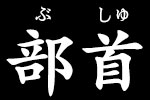🧩 What Is a Radical?

In kanji, a radical (ぶしゅ) is like a building block — a part of the character that often hints at its meaning, its structure, or its origin. Every kanji has one official radical, even though many kanji contain multiple meaningful components.
Radicals help us:
- Understand how kanji are constructed
- Group kanji by theme or appearance
- Look up kanji in dictionaries
One Radical, Many Parts
Many kanji are made of two or more parts, and often both sides carry meaning. But for classification, only one part is chosen as the official radical. This is sometimes logical, sometimes traditional — and sometimes just based on where it appears in the character.
Think of the radical as a “filing label” — useful for sorting and organizing, but not always the most meaningful part of the kanji.
 Example 1:
Example 1:
話 (to speak)
- Left: 言(ごんべん / official radical)
- Right: 舌(した / classified as そのほか)
In this case, both parts relate to speaking: 言 means “speech,” and 舌 means “tongue.” The radical is clearly semantic, and the right side adds meaning as well. Since 舌 appears on the right and is considered a weaker component, it doesn’t serve as the radical here. While 舌 can be a radical in a few specific cases, it isn’t in this one. For kanji with 言 on the left, the radical is consistently ごんべん ... ➡️
 Example 2:
Example 2: 競 (to compete)
This kanji is a great example of how radicals are chosen for classification more than for meaning. All three parts — 立, 口, and 儿 — contribute to the concept of "competing," but only 立 is officially recognized as the radical.
Why? Because 立 appears in a standard radical position (top-left) and has historically been used for sorting. The other components, while meaningful and often used as radicals in other kanji, are not considered radicals in this particular case.
This highlights an important point: the official radical isn’t always the most meaningful part. To truly understand a kanji, you need to look at all its elements together.
🔧 Radicals Can Show:
- Meaning clues (e.g. 言 = speech)
- Semantic categories (e.g. 心 for emotions)
- Shape groupings (e.g. small dots or hooks)
But remember: some radicals, like ⼁ or 亅, don’t carry clear meaning — they just help organize kanji by shape.
💡 Good to Know
- There are 214 traditional radicals, based on the Kangxi dictionary from China.
- Modern Japanese systems may use slightly different lists, and here in Kanji World, we focus on 129 of the most common and useful radicals.
- Radicals appear in many forms: left-side (へん), top (かんむり), bottom (あし), and enclosing shapes (かまえ).
- Even simple strokes like a dot (てん) or hook (はねぼう) can be radicals.
🧠 Kanji World Tip
When studying a kanji, look beyond just the radical. Look at all its parts — both the radical and phonetic elements — to better understand its meaning, sound, and history.
Remember, radicals are mainly chosen for sorting, not always for meaning. They’re helpful labels — but not the whole story.
Now that you know how they work, use that knowledge to explore kanji more deeply.